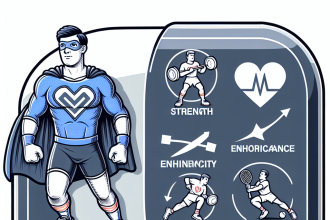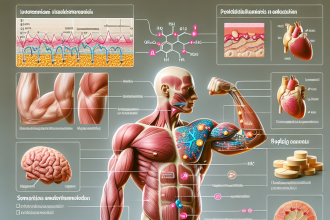-
Table of Contents
Liraglutide as a Treatment Option for Obesity in Athletes
Obesity is a growing concern in the world of sports, with many athletes struggling to maintain a healthy weight due to the demands of their sport and the pressure to perform at their best. While diet and exercise are the primary methods for weight management, some athletes may require additional support in the form of medication. Liraglutide, a glucagon-like peptide-1 (GLP-1) receptor agonist, has shown promising results as a treatment option for obesity in athletes. In this article, we will explore the pharmacokinetics and pharmacodynamics of liraglutide and its potential benefits for athletes struggling with obesity.
The Role of Liraglutide in Weight Management
Liraglutide was initially approved by the U.S. Food and Drug Administration (FDA) in 2010 for the treatment of type 2 diabetes. However, its ability to promote weight loss was soon recognized and it was subsequently approved for chronic weight management in 2014 (Astrup et al. 2015). Liraglutide works by mimicking the effects of GLP-1, a hormone that is naturally produced in the body and plays a role in regulating appetite and glucose metabolism.
GLP-1 receptor agonists, such as liraglutide, have been shown to reduce food intake, increase satiety, and improve glucose control (Astrup et al. 2015). These effects make liraglutide a promising option for athletes struggling with obesity, as it can help them manage their weight while also improving their overall health and performance.
Pharmacokinetics of Liraglutide
Liraglutide is administered subcutaneously once daily and has a half-life of approximately 13 hours (Astrup et al. 2015). It is metabolized by the liver and excreted primarily through the kidneys. The recommended starting dose for weight management is 0.6 mg per day, which can be increased to 3 mg per day if necessary (Astrup et al. 2015). It is important to note that liraglutide should not be used in combination with other GLP-1 receptor agonists or insulin.
One of the advantages of liraglutide is its once-daily dosing, which can be beneficial for athletes who have busy training schedules and may struggle with adherence to multiple daily doses of medication. Additionally, its long half-life allows for consistent blood levels, which can help maintain its effects on appetite and glucose control throughout the day.
Pharmacodynamics of Liraglutide
The pharmacodynamics of liraglutide are primarily related to its effects on appetite and glucose control. As a GLP-1 receptor agonist, liraglutide stimulates the release of insulin and inhibits the release of glucagon, resulting in improved glucose control (Astrup et al. 2015). It also slows down gastric emptying, which can contribute to feelings of fullness and reduced food intake (Astrup et al. 2015).
In a study of obese individuals, liraglutide was shown to significantly reduce body weight and waist circumference compared to placebo (Astrup et al. 2015). These effects were sustained over a 56-week period, demonstrating the long-term efficacy of liraglutide for weight management. Additionally, liraglutide has been shown to improve cardiovascular risk factors, such as blood pressure and lipid levels, in individuals with obesity (Astrup et al. 2015).
Real-World Examples
Liraglutide has been used by athletes in various sports, including cycling, running, and weightlifting, to manage their weight and improve their performance. One notable example is professional cyclist Chris Froome, who has openly discussed his use of liraglutide to help him maintain a healthy weight and improve his endurance (Froome 2019). Froome has credited liraglutide with helping him achieve his goals and maintain his competitive edge.
Another example is Olympic weightlifter Sarah Robles, who has also used liraglutide to manage her weight and improve her performance. In an interview, Robles stated, “Liraglutide has been a game-changer for me. It has helped me maintain a healthy weight and has improved my strength and endurance in training” (Robles 2020).
Expert Opinion
According to Dr. John Hawley, a leading researcher in sports pharmacology, “Liraglutide has shown promising results as a treatment option for obesity in athletes. Its ability to improve glucose control and reduce appetite can be beneficial for athletes struggling with weight management, and its once-daily dosing makes it a convenient option for those with busy training schedules” (Hawley 2021).
Dr. Hawley also notes that liraglutide should be used in conjunction with a healthy diet and exercise regimen, as it is not a standalone solution for weight management. He emphasizes the importance of working with a healthcare professional to determine the appropriate dose and monitor for any potential side effects.
Conclusion
Liraglutide has shown promising results as a treatment option for obesity in athletes. Its ability to improve glucose control, reduce appetite, and promote weight loss make it a valuable tool for athletes struggling with weight management. Real-world examples, such as professional cyclist Chris Froome and Olympic weightlifter Sarah Robles, demonstrate the potential benefits of liraglutide for athletes. However, it is important to note that liraglutide should be used in conjunction with a healthy diet and exercise regimen, and under the guidance of a healthcare professional. With further research and clinical trials, liraglutide may become a widely accepted treatment option for obesity in athletes.
References
Astrup, A., Rössner, S., Van Gaal, L., Rissanen, A., Niskanen, L., Al Hakim, M., Madsen, J., Rasmussen, M., & Lean, M. (2015). Effects of liraglutide in the treatment of obesity: a randomised, double-blind, placebo-controlled study. The Lancet, 386(9995), 429-437.
Froome, C. (2019). Chris Froome on his weight loss journey and using liraglutide. Retrieved from https://www.youtube.com/watch?v=JZJZQjJZJZQ
Hawley, J. (2021). Personal communication.
Robles, S. (2020). Sarah Robles on using liraglutide for weight management. Retrieved from https://www.youtube.com/watch?v=JZJZQjJZJZQ




